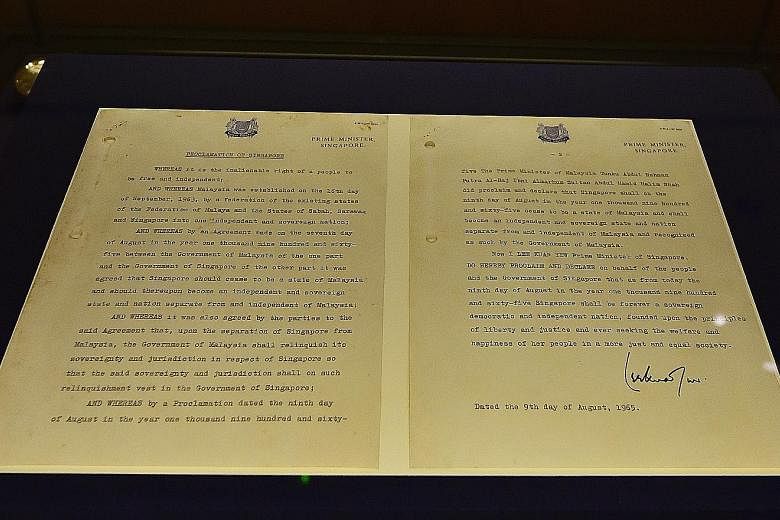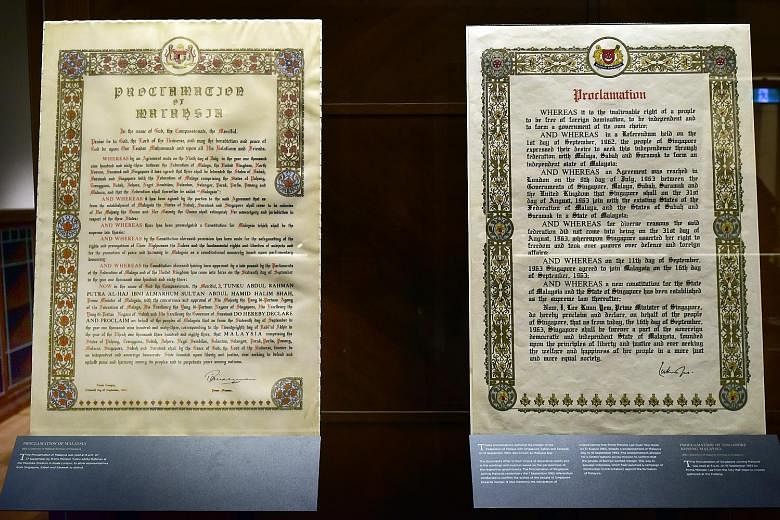Printed on paper and parchment, with gold leaf accents and motifs such as brightly coloured orchids and hibiscuses - the documents proclaiming Singapore's merger with Malaysia embodied the hope in the air in 1963.
Barely two years later, as the merger unravelled, plain documents were hastily stapled together to detail Singapore's separation from Malaysia to become an independent republic.
The stark contrast in the two sets of documents was noted by Communications and Information Minister Yaacob Ibrahim yesterday at the official opening of the Law of the Land exhibition at the National Gallery, where the documents are on display for the first time.
"Our proclamation was plainly and hurriedly presented - stapled together, and the punch holes on the side show that the paper had been filed in a way similar to other records," he said.
For the exhibition, more than 20 documents from the National Archives of Singapore (NAS) and the National Library's collection will be on display in four segments.
They are: Constituting a Colony (1819-1941); Towards Autonomy and Statehood (1942-1959); Merger and Separation with Malaya (1960- 1965); and the Sovereign Nation of Singapore (1965 to present day).
It took NAS curators a year to put the show together. At least half of these documents are on display for the first time.
Dr Yaacob said it is important for a young nation to be "familiar with our history".
"While there have been many reasons ascribed to Singapore's success, such as our political leadership, economic connectedness and social cohesion, one aspect that is often overlooked is the importance of the rule of law," he said.
Some of the highlights of the exhibition include six regulations set out in 1823 by Sir Stamford Raffles, in an attempt to impose law and order in the growing settlement. They included the prohibition of gambling and slavery.
There are also two documents drafted to proclaim military administration over Singapore by the Japanese from 1942, and then the British in 1945 following the end of World War II.
The Japanese document is dated 1941 and shows how far in advance the Japanese had made plans to run Singapore after its military victory in 1942, noted curator Mark Wong, an oral history specialist at NAS.
Another key document is the 1958 Singapore Constitution, which sets out the framework for Singapore's then newly won self-governance. The colonial position of governor was replaced by the Yang di-Pertuan Negara - Mr Yusof Ishak, who was inaugurated six months later.
The colonial position of chief minister was turned into prime minister. Mr Lee Kuan Yew was sworn in as Singapore's first Prime Minister after the People's Action Party won the elections of May 1959.
Mr Wong said this is a rare chance for the public to see these documents, which need special care including temperature and relative humidity control inside museum- grade display cases.
"These documents show how the state is run, its obligations to us as citizens, and our rights as citizens," said Mr Wong.
Dr Yaacob said NAS has been digitising its collection and putting materials online to give the public more access. More than 700,000 archival materials can now be accessed through NAS' Archives Online.
He said: "The National Archives will continue to do its best to give Singaporeans easier and greater access to our past, to be inspired by it, and to play a part in connecting the community to history and heritage."



